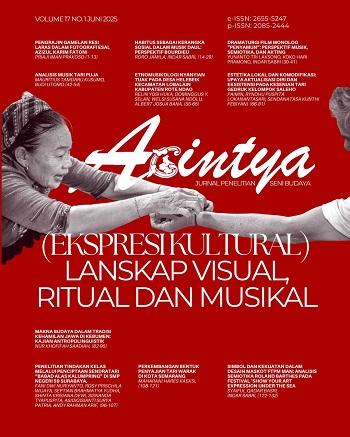THE DEVELOPMENT OF WARAK DANCE PRESENTATION FORMS IN SEMARANG CITY
DOI:
https://doi.org/10.33153/acy.v17i1.7666Keywords:
ethnochoreology, development, innovation, warak danceAbstract
The Warak Dhugdhèr dance is a form of creation dance in Semarang city. In its performance, the dance brings the property of warak ngêndhog, a mythological creatures in the dhugdhèran tradition symbolizing the unity of Javanese, Chinese, and Arabic cultures. This dance was created by Didik Nini Thowok and Yoyok Bambang Priyambodo and first performed was in 2006. In its development, innovations emerged in new Warak dance forms that were performed at the Warak Dance Festival and also in the community environment. This study aims to analyze the development of Warak dance presentation forms that have grown and developed in Semarang. This study uses a qualitative research method with an ethnochoreology approach in its application. The methods applied in this study consist of the stages of problem identification, data collection, data analysis, and conclusions. The findings reveal that adaptation and innovation are manifested in structural changes, such as choreography, music, makeup and costume, and the form of warak itself. Three main directions of development: the preservation of Warak ngêndhog iconography as properties, adaptation to the socio-cultural context, and the emergence of several new forms of Warak Dance such as the Manggar Warak dance, Ronggeng Warak dance, and Semarak Warak dance. These developments are driven by the creative reinterpretation of the artists who created it, government policies regarding culture, and community participation. This study concludes that new forms of Warak Dance have grown dynamically through processes of adaptation and innovation. Innovation and development efforts are also continuously carried out in order to adapt to the socio-cultural conditions in Semarang city.
Downloads
References
Ahimsa-Putra, H. S. (2008). Etnosains untuk Etnokoreologi Nusantara (Antropologi dan Khasanah Tari). In R. M. Pramutomo (Ed.), Etnokoreologi Nusantara (Batasan Kajian, Sistematika, dan Aplikasi Keilmuannya). ISI Press.
Boyle, M. S. (2015). Against Renovation! Performance and Brechtian Innovation Performing Dialectics, 30 January 2015 Michael Shane Boyle Queen Mary, University of London. January.
Cahyono, C. (2018). Warak Ngendog Dalam Tradisi Dugderan Sebagai Representasi Identitas Muslim Urban Di Kota Semarang. Jurnal Theologia, 29(2), 339–362. https://doi.org/10.21580/teo.2018.29.2.2937
Frankelius, P. (2011). Innovation processes: Experience drawn from the creation of Dalhalla. Art Entrepreneurship, 6(2), 98–141. https://doi.org/10.4337/9781849808507.00013
Hadi, Y. S. (2005). Sosiologi Tari. Penerbit Pustaka.
Kaeksi, M. H., Fitriasari, R. P. D., & Sushartami, W. (2020). Transformasi Warak Ngendhog Menjadi Tari Warak Dhugdher Di Kota Semarang. Jurnal Seni Tari, 9(1), 1–10. https://journal.unnes.ac.id/sju/index.php/jst/article/view/36954%0Ahttp://journal.unnes.ac.id/sju/index.php/jst
Muhammad, D. (2014). Meluruskan Bentuk Warak Ngedok. https://www.academia.edu/6511321/MELURUSKAN_BENTUK_WARAK_NGENDOK?auto=download
Poerwadarminta, W. J. . (1939). Baoesastra Djawa. Groningen, 75.
Puspita, S. K., Wadiyo, & Wibawanto, W. (2023). Kajian Interdisiplin: Telaah Seni Rupa dan Tari Melalui Teori Akulturasi dan Teori Motivasi pada Tari Ronggeng Warak Karya Tari Sekar Kemuning. Jurnal of Islamic Art and Architecture, 1(2), 69–73. https://journal.walisongo.ac.id/index.php/JIAA/index
Rahmawati, A., & Afrizal, A. (2023). Eksistensi dan Karakteristik Batik Motif Warak Ngendog di Kampung Batik Semarang dalam Era Modern. Texture:Art and Culture Journal, 6(1), 59–68. https://doi.org/10.33153/texture.v6i1.5466
Sanders, J. (2017). Sanders, Julie. Adaptation and Appropriation. In Forum for Modern Language Studies (Vol. 53, Issue 1). https://doi.org/10.1093/fmls/cqw047
Senoprabowo, A., Khamadi, K., & Septian, Y. A. (2021). Komik Digital Warak Ngendog Untuk Memperkenalkan Nilai Kearifan Lokal Kepada Anak Di Kota Semarang. Prosiding Seminar Nasional Desain Komunikasi Visual, 1(2020), 1–13. https://doi.org/10.33479/sndkv.v1i.76
Supendi, E., Sri Kuncoro, J., & Suroto, S. (2023). Kolaborasi Karya Tari Suara Hati. Acintya Jurnal Penelitian Seni Budaya, 15(1), 11–19. https://doi.org/10.33153/acy.v15i1.5059
Supramono. (2007). Makna Warak Ngendhog dalam Tradisi Ritual Dugderan di Kota Semarang [Universitas Negeri Semarang]. https://www.academia.edu/31892826/MAKNA_WARAK_NGENDOG_DALAM_TRADISI_RITUAL_DUGDERAN_DI_KOTA_SEMARANG
Wibowo, A. K., & Samsuri, S. (2023). Estetika Garap Tubuh dan Properti dalam Karya Tari Gandhewa Raga. Acintya Jurnal Penelitian Seni Budaya, 14(2), 205–211. https://doi.org/10.33153/acy.v14i2.4675
Widyati, A., Malarsih, M., & Hartono, H. (2024). Catharsis : Journal of Arts Education Contribution of the Ronggeng Warak Dance in Improving the Creative Economy Industry at Sanggar Sekar Kemuning , Pedurungan District , Semarang City. 13(1), 34–41.
Zarkasi, M. S., & Tri Suwasono, B. (2022). Teknik Pounding Pada Ecoprint Sebagai Sumber Isnpirasi Dalam Penciptaan Karya Seni Grafis Abstraksi Wayang. Acintya : Jurnal Penelitian Seni Budaya, 14(1), 53–65. https://doi.org/10.33153/acy.v14i1.4327
Downloads
Published
How to Cite
Issue
Section
License
Copyright (c) 2025 Maharani Hares Kaeksi

This work is licensed under a Creative Commons Attribution 4.0 International License.
Author continues to retain the copyright if the article is published in this journal. The publisher will only need publishing rights




